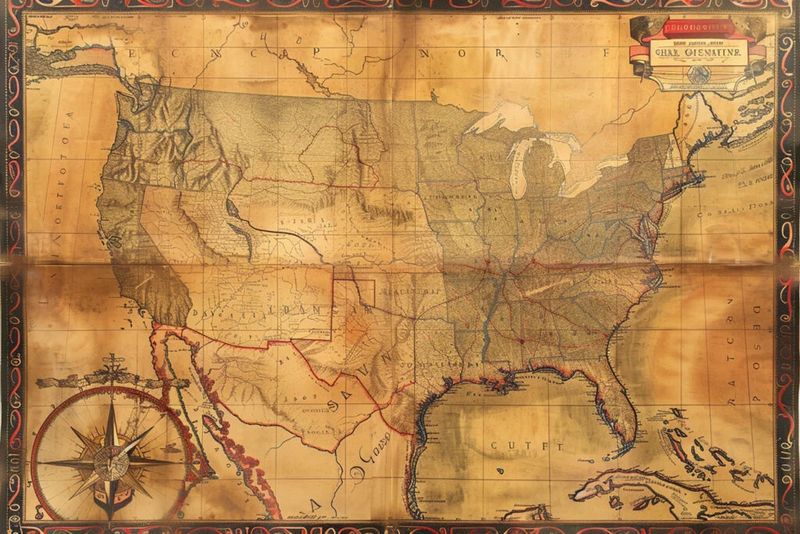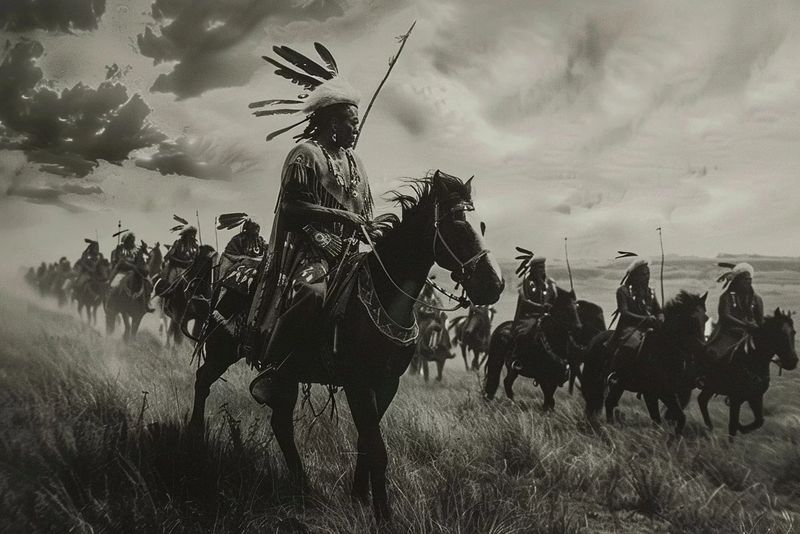
“Comancheria” refers to the domain of the Comanche people, a Native American tribe, which stretched across the Great Plains of North America. In the 18th and 19th centuries, the Comanche established a vast and influential presence in the region, often referred to as the “Comanche Empire” or the “Almost Empire of the Great Plains.”
The Comanche were renowned for their mastery of horsemanship and warfare, which enabled them to dominate large swathes of territory, ranging from present-day Texas, New Mexico, Oklahoma, Colorado, and Kansas. Their control over these lands facilitated trade, raiding, and influence over other Native American tribes and European settlers alike.
The Comanche way of life centered around buffalo hunting and a nomadic lifestyle, following the seasonal movements of the buffalo herds. This lifestyle, combined with their military prowess, allowed them to maintain their dominance over the Great Plains for centuries.
However, the decline of the Comanche Empire began in the mid-19th century with the encroachment of European settlers, diseases introduced by Europeans, and the decimation of the buffalo population. Ultimately, the Comanche were forced onto reservations by the late 19th century, marking the end of their era as the dominant power of the Great Plains.

The Territory of Comancheria
The territory of Comancheria encompassed a vast expanse across the Great Plains, characterized by the dominance of the Comanche people. This region was not defined by rigid borders but rather by the extent of Comanche influence, marked by their raids and trade routes. From the Arkansas River to the Brazos, and from the Red River to the Rio Grande, Comancheria spanned a wide area where Comanche law held sway and their warriors were revered.
Comancheria operated as a decentralized entity, lacking a centralized governing structure. Instead, it consisted of semi-autonomous bands, each with its own leadership and decision-making processes. Despite this decentralization, the bands were united by a shared language, culture, and common interests, creating a sense of unity within diversity.
Within Comancheria, the Comanche people lived a nomadic lifestyle, following the movements of the buffalo herds for sustenance. Their society was organized around principles of kinship and cooperation, with leadership roles often earned through acts of bravery and skill in hunting and warfare.
Overall, Comancheria represented a dynamic and fluid territorial entity, reflecting the adaptability and resilience of the Comanche people in the face of changing circumstances on the Great Plains.
Sociopolitical Structure: Independence within Unity
The sociopolitical structure of Comancheria was characterized by a balance between independence and unity. Although the territory lacked a centralized authority, it operated as a loose confederation of autonomous bands, each with its own leadership and decision-making processes. Despite this decentralized nature, there existed a strong sense of unity among the Comanche people, bound together by shared language, culture, and common interests.
Within this structure, each band operated independently, making decisions based on their specific circumstances and needs. Leadership positions were often earned through acts of bravery and skill, particularly in warfare and raiding, reflecting a meritocratic system where leaders were chosen for their abilities rather than inherited status.
Despite the autonomy of individual bands, there was a sense of solidarity and cooperation among the Comanche people. They frequently collaborated on matters of mutual interest, such as defense against external threats or organizing large-scale buffalo hunts. This unity within diversity allowed the Comanche to maintain their sovereignty and influence over a vast territory without the need for a centralized authority.
Overall, the sociopolitical structure of Comancheria exemplified a delicate balance between independence and unity, where individual bands retained their autonomy while working together towards common goals, reflecting the adaptability and resilience of the Comanche people in navigating the challenges of the Great Plains.
The Lingua Franca of the Plains
The Comanche were indeed masters of trade and diplomacy on the Great Plains. Their strategic location at the crossroads of various indigenous groups and their nomadic lifestyle enabled them to establish extensive trade networks and forge diplomatic relationships with neighboring tribes and European settlers.
Trade played a vital role in Comanche society, facilitating the exchange of goods such as horses, buffalo hides, weapons, and other resources. As skilled horsemen, the Comanche controlled vast herds of horses, which they traded with neighboring tribes for goods they lacked. This trade network not only ensured the prosperity of the Comanche but also fostered alliances and cooperation with other indigenous groups.
Diplomacy was another key aspect of Comanche governance. The Comanche were adept at negotiating treaties and agreements with both indigenous tribes and European powers, often playing rival factions against each other to their advantage. Their reputation as fierce warriors and shrewd negotiators made them formidable allies and respected adversaries.
Overall, the Comanche’s mastery of trade and diplomacy allowed them to exert significant influence over the Great Plains region, shaping its political and economic landscape for centuries.
The Military Might of the Comanche
The Comanche were renowned for their formidable military prowess, which played a crucial role in establishing and maintaining their dominance over the Great Plains. Their military might stemmed from several factors, including their mastery of horsemanship, strategic warfare tactics, and adaptability to the nomadic lifestyle of the Plains.
Horsemanship was central to Comanche warfare. They were among the finest horsemen in North America, skilled in riding, shooting arrows, and maneuvering swiftly on horseback. This mobility allowed them to launch devastating raids on enemy settlements, quickly retreat, and evade pursuit.
Strategic warfare tactics also contributed to the Comanche’s military success. They utilized hit-and-run tactics, ambushes, and feigned retreats to outmaneuver and outwit their opponents. Their knowledge of the terrain and ability to navigate the vast expanses of the Plains gave them a distinct advantage in battles.
Furthermore, the Comanche were adept at adapting to changing circumstances and incorporating new technologies into their military strategies. They quickly adopted firearms acquired through trade with European settlers, enhancing their firepower and effectiveness in combat.
The Comanche’s military might not only enabled them to defend their territory but also to expand their influence through conquest and intimidation. Their reputation as fierce warriors and skilled tacticians made them formidable adversaries and respected allies among both indigenous tribes and European powers on the frontier.
Overall, the Comanche’s military prowess was a defining characteristic of their society, shaping their interactions with neighboring groups and contributing to their status as one of the most powerful indigenous nations on the Great Plains.
The Ebbing of an Empire
The decline of the Comanche Empire began in the mid-19th century, marked by a combination of internal and external factors that gradually eroded their power and influence over the Great Plains.
One significant factor in the ebbing of the Comanche Empire was the encroachment of European settlers and the expansion of the United States into Comanche territory. As settlers moved westward, they brought with them diseases that decimated indigenous populations, disrupting traditional ways of life and weakening the Comanche’s ability to resist.
Additionally, the decline of the buffalo population, a primary food source and economic resource for the Comanche, further destabilized their society. Overhunting by European settlers and the construction of railroads led to the near-extinction of the buffalo herds, depriving the Comanche of a vital source of sustenance and trade.
Military conflicts with the United States also took a toll on the Comanche Empire. The U.S. Army launched campaigns to subdue and relocate indigenous populations onto reservations, leading to armed resistance and displacement for many Comanche bands. Despite their valiant efforts, the Comanche were ultimately overwhelmed by the superior numbers and firepower of the U.S. military.
Internally, the Comanche faced challenges in adapting to changing circumstances and maintaining unity among their bands. The disruption caused by disease, loss of traditional lands, and depletion of resources contributed to internal divisions and conflicts within Comanche society.
By the late 19th century, the Comanche Empire had largely been dismantled, and the remaining Comanche bands were forced onto reservations, where they faced ongoing challenges in adjusting to a sedentary way of life and preserving their cultural identity.
Overall, the decline of the Comanche Empire was a complex process driven by a combination of external pressures and internal challenges, ultimately leading to the loss of their sovereignty and independence on the Great Plains.
The Cultural Legacy of the Comanches
The Comanche legacy endures as a significant cultural influence on the Great Plains and beyond. Despite the challenges and changes they faced over the centuries, the Comanche left a lasting imprint on various aspects of North American culture, including language, art, traditions, and the enduring image of the Native American warrior.
- Language: The Comanche language continues to be spoken by descendants of the Comanche people and is recognized as an important part of their cultural heritage. Efforts to preserve and revitalize the language contribute to the preservation of Comanche identity and traditions.
- Art and Crafts: Comanche artistic traditions, including beadwork, quillwork, and traditional clothing, are celebrated for their intricate designs and craftsmanship. These art forms are passed down through generations and are valued both within Comanche communities and in the wider art world.
- Traditions and Ceremonies: Many traditional Comanche ceremonies and rituals are still practiced today, serving as important cultural touchstones for the community. These include ceremonies related to coming of age, healing, and honoring ancestors, which help to reinforce a sense of identity and continuity among the Comanche people.
- Stories and Legends: Comanche oral traditions, including stories, legends, and songs, continue to be passed down through generations, preserving the collective memory and wisdom of the Comanche people. These stories often reflect the values, beliefs, and experiences of the community and play a vital role in cultural transmission.
- Identity and Representation: The image of the Comanche warrior, with their skill in horsemanship and bravery in battle, remains a powerful symbol in popular culture and the collective imagination. This enduring image reflects the resilience, strength, and pride of the Comanche people and serves as a reminder of their rich cultural heritage.
Overall, the cultural legacy of the Comanches continues to shape and inspire contemporary indigenous communities and broader society, serving as a testament to their resilience, adaptability, and enduring contributions to North American history and culture.